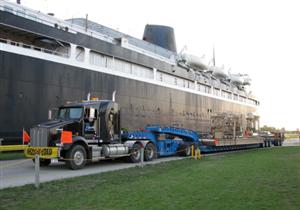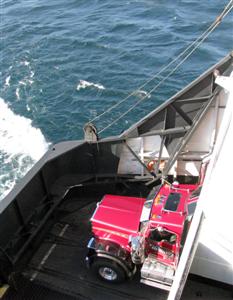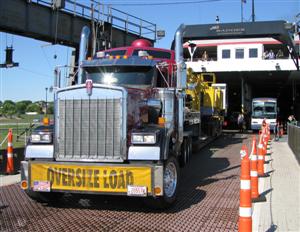November 2008 TRUCKER TALK
LET THE CAPTAIN DRIVE
BY WRITER & OWNER OPERATOR KIM GRIMM
I took the week of my birthday off in September and had an opportunity to go trucking like I’ve never trucked before – on a ferry across Lake Michigan! If you ever get the chance to put your truck and trailer on a ferry and leave the driving to the captain, take it. Before this trip I really thought I’d been out over the water when I crossed the Chesapeake Bay Bridge, but compared to this trip, that was nothing.
On Monday, my friend Pete and I loaded a big crane body in Green Bay, WI that was destined for Midland, MI. But instead of getting permits for a super load in Illinois and Indiana and taking the long route down and around through Chicago, we reserved a spot on the S.S. Badger ferry that would leave from Manitowoc, WI at 2 p.m. on Tuesday and then arrive in Ludington, MI, just 115 miles from our delivery location, at 6 p.m. This put us in great shape to be on-time for our Wednesday morning drop.
The rate is based on the width and length of your vehicle and we were 88’ long and 12’ 6” wide – big enough to cost $900. That may sound like a lot for a four hour boat ride, but if you think about it and do the math (permits, fuel, wear and tear on the truck and time), it was actually pretty cheap. When we delivered on Wednesday, we had logged less than 200 miles on the trip and had enjoyed a great ride. For regular-sized trucks and trailers, the cost is only $270. They also have a special rate for truckers that ride the ferry regularly ($240). That’s worth it just to avoid going through Chicago!
 The ship sails from the first of May to the middle of October, with two trips a day from June to September. The S.S. Badger is the largest car ferry to sail on Lake Michigan and the only coal fired ship still in operation in North America. The S.S. Badger operates on domestic fuel which is piled up right across from the dock. The company has an extraordinary commitment to maintaining the ship’s unique propulsion system, which was recently designated as a national mechanical engineering landmark. Two giant, cast steel four-blade propellers measuring 13’ 10” in diameter, each weighing 13,800 pounds, move the S.S. Badger along at 18 mph. Think about it – those propellers are taller than most of our trailers! When at the dock, two 7,000 pound stockless anchors help keep the ship secured.
The ship sails from the first of May to the middle of October, with two trips a day from June to September. The S.S. Badger is the largest car ferry to sail on Lake Michigan and the only coal fired ship still in operation in North America. The S.S. Badger operates on domestic fuel which is piled up right across from the dock. The company has an extraordinary commitment to maintaining the ship’s unique propulsion system, which was recently designated as a national mechanical engineering landmark. Two giant, cast steel four-blade propellers measuring 13’ 10” in diameter, each weighing 13,800 pounds, move the S.S. Badger along at 18 mph. Think about it – those propellers are taller than most of our trailers! When at the dock, two 7,000 pound stockless anchors help keep the ship secured.
After they unloaded everyone who had rode the early trip over from Ludington, we watched as they backed trucks into the ferry and dumped at least two loads of coal. What a way to fuel up! Then they started loading all of the cars first, then the other trucks, one bus, and then we were the last ones to back on. Being on the end, I was able to take some really cool pictures from the deck above of the truck on the boat with the water right there. The Lake Michigan Car Ferry personnel have to drive the cars on, but they let the truck drivers back in their own trucks. Every vehicle loaded on the ship is backed in so the owners can drive straight off when it arrives at the dock on the other end.
The S.S. Badger is 410’ long, 59’ 6” wide, 106’ 9” tall (7 stories) and 6,650 tons displaced. The ferry has outside decks, 40 staterooms, a movie lounge, an upper deck lounge, a video arcade, two television rooms, a gift shop and a buffet-style dining area. Since the 911 attacks, you no longer have access to your truck while on the boat, so if you want to take a nap you have to get a stateroom, which costs $44. These rooms are a great place to lie down when the water gets a little rougher out in the middle of the lake and you start to feel sick. I felt sick at one point, but I didn’t throw up!
The world’s first steel-hulled railroad car ferry began service between Manitowoc, WI and Ludington, MI in 1897. Ludington was the world’s busiest car ferry port by the 1940’s, with several of the big “black boats” operating 365 days a year to three different Wisconsin cities. The S.S. Badger was the largest car ferry ever built for Great Lakes service and was launched at the peak of the era in 1953. The S.S. Badger was designed to handle the rough conditions she would encounter while sailing Lake Michigan year-round.
Even though her mission has changed from carrying railroad cars to passengers and their vehicles, the role she plays in the economies and hearts of the areas she serves has not. A living legend, the S.S. Badger is the continuation of a century-old maritime tradition. The company celebrates this heritage onboard the ship by providing historical interpreters, self-guided tours and displays of maritime memorabilia.
 With perfect weather, our ride across the lake on Tuesday was fantastic. It was a little chilly but the sun was shining, which made for a very scenic ride. What a way to truck! No scales, no stupid drivers pulling out in front of you and no worries – just a great shortcut over open waters and four hours to relax and do as you please. You can’t say that about trucking any other way.
With perfect weather, our ride across the lake on Tuesday was fantastic. It was a little chilly but the sun was shining, which made for a very scenic ride. What a way to truck! No scales, no stupid drivers pulling out in front of you and no worries – just a great shortcut over open waters and four hours to relax and do as you please. You can’t say that about trucking any other way.
After getting empty we decided not to go down through Chicago and instead went north across the Mackinac Bridge onto Michigan’s Upper Peninsula, another place I’d never been before. The Mackinac Bridge, which spans five miles, is the third longest suspension bridge in the world. From there we took Hwy. 2 which runs along the north shore of the lake. We stopped a couple of times so I could get some neat pictures – the sunset in Manistique, MI was great. With a lighthouse in the little bay, sand and grass and a few birds just gliding around, it was absolutely spectacular. It was the perfect end to a trip that was more like a vacation than hauling a load.
My good friend (and 10-4’s resident trucker/poet) Trevor Hardwick, who resides in the state of Washington, puts his truck and trailer on the Walla Walla or the Spokane ferry every day. He travels the Edmonds to Kingston route, crossing the Puget Sound. There is a boat leaving every 50 minutes, with the trip taking about 25 minutes. On his ship, unlike ours, Trevor can stay in the truck and catch a little cat nap. There are several routes in the Seattle, WA area that allow trucks and trailers onboard. These are much shorter rides than going across Lake Michigan, but, like our trip, they are scenic, economical and relaxing shortcuts.
If you are looking for a short and scenic tour (or if you happen to have a delivery), there are ferries that service the islands of Martha’s Vineyard and Nantucket, off the coast of Massachusetts, that allow trucks and trailers. I’m sure they don’t see or want too many trucks out there, but I bet that it is a beautiful trip. If you look on your map or atlas you can see the dashed lines that indicate where many of the ferries run. Just be sure to call ahead and confirm that trucks and trailers are allowed (you’ll probably need to make reservations anyway).
If you want to take a truly exciting ferry ride (with or without your truck), check out “The CAT” that runs between Bar Harbor, ME and Yarmouth, Nova Scotia, and another that runs between Portland, ME and Nova Scotia. These high-speed, ultra-luxurious and modern ferries can whisk you from Bar Harbor to Yarmouth in three hours or from Portland to Yarmouth in 5-1/2 hours. These catamaran-style ferries feature fine dining, a casino, several TV/movie lounges, floor to ceiling glass windows for unprecedented ocean and coastline views, a duty-free gift shop and reclining lounge seats – and all of these amenities can be enjoyed while sailing along at highway speeds! Check them out at www.catferry.com – they look pretty cool.
Most ferry rides are scenic tours, like going to the Statue of Liberty or whale watching, or maybe a ride under the Golden Gate Bridge and around Alcatraz. But if you ever get the chance to let the captain do the driving while you enjoy the ride (and deliver a load), take it. I sure hope that I get the chance to go again some day soon!
